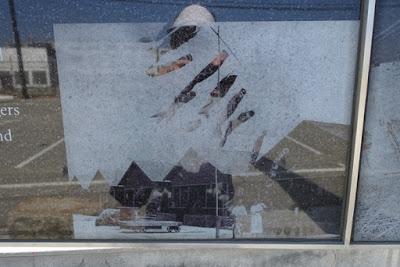
Japanese Fishing Village Memorial on Terminal Island, San Pedro, California
From the early 1900s until World War II, the fishing village of Fish Harbor on Terminal Island was a thriving community of 3000 people—primarily Japanese immigrants and their U.S.-born children. The canneries and fishing boats played a vital role in the American fishing industry. In the village’s neat rows of shops and homes, people loved, laughed, worked, played and raised families. On February 25, 1942, all those of Japanese descent were given 48 hours to leave Terminal Island. By April the village was gone, homes and livelihoods taken away and villagers sent to internment camps.
We remember these people, and the community of Terminal Island that was their home.(From the first panel of the photo mural at the base of the Terminal Island Memorial.)

Life-size figures of two fishermen
Although I was aware of other communities of Japanese heritage in Los Angeles--in West Los Angeles along Sawtelle Boulevard and in Little Tokyo downtown--I had never heard of Fish Harbor, the Japanese fishing village on Terminal Island. It was only because we took a wrong turn on a recent excursion to San Pedro, that we discovered this poignant and sobering memorial to its history.
Center panel of Torii Gate
Terminal Island is the industrial port of Los Angeles and Long Beach. As we headed south on the 110 Freeway toward San Pedro from Los Angeles, we missed our turn and found ourselves heading east on Highway 47 crossing the Vincent Thomas Bridge to Terminal Island. As we exited to find a place to turn around, we spotted a small sign pointing to the Japanese Fishing Village Memorial. We were intrigued.So, following a zigzag route past warehouses and vast industrial shipyards, we eventually came to a roadside display of a pair of sculptured fishermen under a Torii gate. (A Torii gate is the traditional entrance to a Shinto shrine in Japan.) We pulled into one of the parking spots and got out to take a close-up look.A raised walkway leads to the Torii gate, which frames the fishermen, who are mounted on a plinth. Along the side of the walkway, names of the donors who made the memorial possible are engraved.

Photo panels on the street side of the memorial.
At street level, a series of photo panels displays pictures of the people and the village as it was before 1942, along with short explanations.“Men fished with poles and nets. Tuna season kept everyone busy in the summer. On dark winter nights, sardines set the ocean aglow.”
“For young girls, Girls’ Day was a day to be celebrated, to dress in their kimonos, display their dolls and perform traditional folk dances."

"On Boys’ Day, the symbolic carp flags were flown, and boys displayed their athletic prowess at the annual track meet.”
The photos are printed on dark panels with a reflective surface, which functions to give the images a ghostly feel as the faces of people merge with the reflections of the present-day world. (In fact, it was impossible to avoid catching my own image in the pictures I took with my camera, making me feel like a bit of an intruder.)
The fishermen sculptures wear real, cloth neckerchiefs.
The memorial sculpture depicts two fishermen at work, one pulling his net up, the other paused for a moment and looking out to sea. The white paint in the fisherman’s eyes gives an intensity to his gaze. He looks through a glass panel on which are engraved a poem and a photo of the town of Fish Harbor as it once was, superimposed on today’s view of a yacht basin and shipyards.
End panel of the memorial.
Black Current off our shore Fishes so plentifulYet, hardships parents endured
We remember
And honor forever
our village no more.(Translation of poem printed on the glass.)
Because of the Covid19 pandemic, there was little activity on Terminal Island. We encountered almost no traffic on the way to the memorial and no one else was there. When I got home, I looked up the history of the Terminal Island Japanese Fishing Village Memorial on the internet, learning that it been put up in 2002 by the descendants of the original inhabitants. I also found a VIDEO with highlights of the 15th anniversary of the dedication day.
The Terminal Island Memorial is an important piece of Los Angeles' hidden history. It took us a wrong turn on the freeway to discover it. I am glad we did.

Photo of Terminal Islanders "Reunion", 1980
